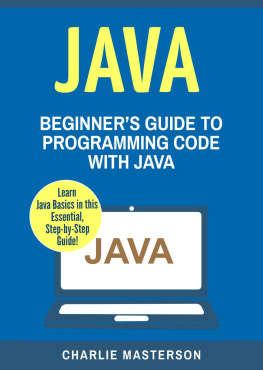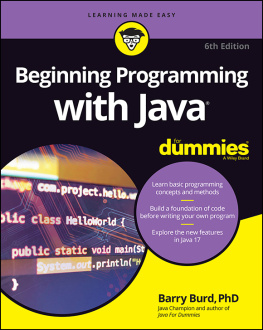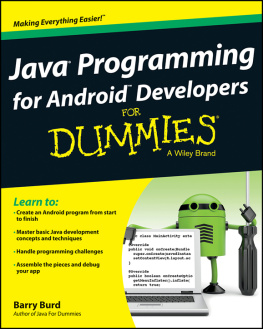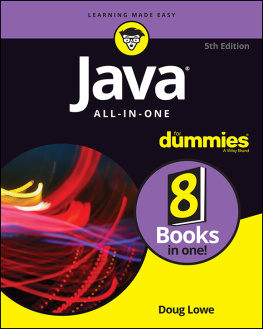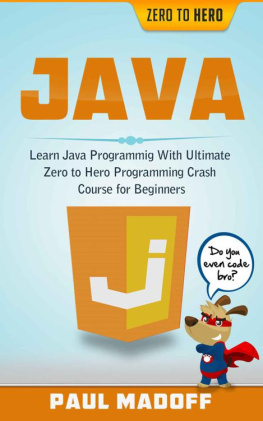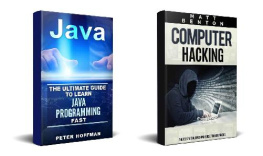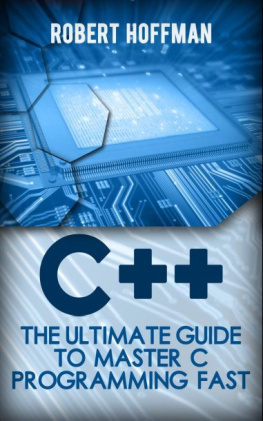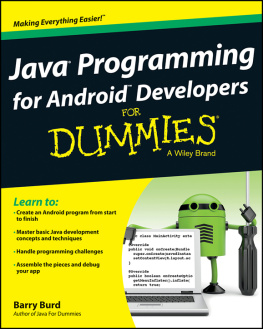John Bach - Learning Java: Beginning programming with java for dummies
Here you can read online John Bach - Learning Java: Beginning programming with java for dummies full text of the book (entire story) in english for free. Download pdf and epub, get meaning, cover and reviews about this ebook. year: 2020, publisher: Amazon Digital Services LLC - KDP Print US, genre: Computer. Description of the work, (preface) as well as reviews are available. Best literature library LitArk.com created for fans of good reading and offers a wide selection of genres:
Romance novel
Science fiction
Adventure
Detective
Science
History
Home and family
Prose
Art
Politics
Computer
Non-fiction
Religion
Business
Children
Humor
Choose a favorite category and find really read worthwhile books. Enjoy immersion in the world of imagination, feel the emotions of the characters or learn something new for yourself, make an fascinating discovery.

Learning Java: Beginning programming with java for dummies: summary, description and annotation
We offer to read an annotation, description, summary or preface (depends on what the author of the book "Learning Java: Beginning programming with java for dummies" wrote himself). If you haven't found the necessary information about the book — write in the comments, we will try to find it.
John Bach: author's other books
Who wrote Learning Java: Beginning programming with java for dummies? Find out the surname, the name of the author of the book and a list of all author's works by series.
Learning Java: Beginning programming with java for dummies — read online for free the complete book (whole text) full work
Below is the text of the book, divided by pages. System saving the place of the last page read, allows you to conveniently read the book "Learning Java: Beginning programming with java for dummies" online for free, without having to search again every time where you left off. Put a bookmark, and you can go to the page where you finished reading at any time.
Font size:
Interval:
Bookmark:
Learning Java  Beginning Programming with Java For Dummies By John Bach For information contact : (alabamamond@gmail.com, memlnc) http://www.memlnc.com First Edition: july 2020 UNITY GAME PROGRAMMING Copyright 2020 by ALEXANDER ARONOWITZ "Programming isn't about what you know; it's about what you can figure out. - Chris Pine
Beginning Programming with Java For Dummies By John Bach For information contact : (alabamamond@gmail.com, memlnc) http://www.memlnc.com First Edition: july 2020 UNITY GAME PROGRAMMING Copyright 2020 by ALEXANDER ARONOWITZ "Programming isn't about what you know; it's about what you can figure out. - Chris Pine  2020 CONTENT Introduction Java Program Execution Basic structures of the Java language A simple program to lang 's ke Java Comments Data types and displaced n nye Constants Big numbers Methods for working with large numbers Operations Converting numeric types Cast Strings Union with t rock Substrings Editing a string Checking strings for equalit y Some methods of the String class Controlling program execution Block scope Conditional statement if - else Multivariate branching - switch statement While and do - while loops cycle for Break statement The continue statement Arrays Copying arrays Sorting arrays Arrays Class Methods Multidimensional array s Command line parameters Cantilever th input-you in odes Objects and Classes Introduction to Object Oriented Programming OOP terminology Differences between OOP and Traditional Procedural Programming Classes New operation An example of using existing classes Constructors Method overloading The this keyword in constructors A note about data encapsulation Static fields and methods Static fields Static methods Initialization blocks Packages Using packages Adding a class to a package Specifying the path to packages Package scope JAR files Class design guidelines Inheritance Extending classes Overriding (overriding) methods Inheritance hierarchy Polymorphism Dynamic linking Preventing Inheritance: Terminal Classes and Methods Abstract classes Protected Access ( protected, ) How to apply inheritance Interfaces Interface operator Implements statement Constants in interfaces Exceptional situations Classification of Exceptions Declaring Method Exceptions How to raise an exceptional situation Creating Exception Classes Catching exceptions ( t ry - catch block ) Catching multiple exceptions Re-raising an exception Finally section How to use exceptions I / O streams Reading and writing bytes Complete family of threads Stream filters Data streams Direct File Streams Text streams Writing text to the output stream Reading text from an input stream Working with files on the th system Letter t hurray
2020 CONTENT Introduction Java Program Execution Basic structures of the Java language A simple program to lang 's ke Java Comments Data types and displaced n nye Constants Big numbers Methods for working with large numbers Operations Converting numeric types Cast Strings Union with t rock Substrings Editing a string Checking strings for equalit y Some methods of the String class Controlling program execution Block scope Conditional statement if - else Multivariate branching - switch statement While and do - while loops cycle for Break statement The continue statement Arrays Copying arrays Sorting arrays Arrays Class Methods Multidimensional array s Command line parameters Cantilever th input-you in odes Objects and Classes Introduction to Object Oriented Programming OOP terminology Differences between OOP and Traditional Procedural Programming Classes New operation An example of using existing classes Constructors Method overloading The this keyword in constructors A note about data encapsulation Static fields and methods Static fields Static methods Initialization blocks Packages Using packages Adding a class to a package Specifying the path to packages Package scope JAR files Class design guidelines Inheritance Extending classes Overriding (overriding) methods Inheritance hierarchy Polymorphism Dynamic linking Preventing Inheritance: Terminal Classes and Methods Abstract classes Protected Access ( protected, ) How to apply inheritance Interfaces Interface operator Implements statement Constants in interfaces Exceptional situations Classification of Exceptions Declaring Method Exceptions How to raise an exceptional situation Creating Exception Classes Catching exceptions ( t ry - catch block ) Catching multiple exceptions Re-raising an exception Finally section How to use exceptions I / O streams Reading and writing bytes Complete family of threads Stream filters Data streams Direct File Streams Text streams Writing text to the output stream Reading text from an input stream Working with files on the th system Letter t hurray
Introduction The Java language was created in the early 90's as part of a software development project for consumer electronic devices. The original new object-oriented programming language was named Oak (oak) . With the development of network Internet language Oak was used to create Internet-applications ( eg, n and this language was written Oak-browser " WebRunner " ) . In 1995, Sun Microsystems decided to announce a new product, renaming it Java (the only reasonable explanation for the name is the love of coffee programmers) , and WebRunner was renamed HotJava . The Java language is now increasingly used to create " middleware " that maintains communication between clients and server resources .
In addition, the Java language has taken over the leadership in embedded systems , becoming the de facto standard for portable devices , on-board car computers, and so on . One of the main advantages of the Java language is independence from the platform on which programs are executed: the same code can be run under Windows , Solaris , Linux , Macintosh , etc. Operating systems . Another advantage is that the syntax of the Java language is similar to the syntax language s C ++ and C . In addition, Java is a completely object-oriented language, even more so than C ++. All entities in the Java language are objects, with the exception of a few primitive types , such as numbers.
In contrast to C ++ , it is easier to develop error-free programs in Java . The Java language provides tools to eliminate the very possibility of creating programs that would hide the most common errors. To do this, the Java language has done the following :
- The possibility of explicit allocation and freeing of memory has been excluded. Java memory is automatically reclaimed by garbage collection. The programmer is guaranteed against errors related to misuse of memory ;
- Introduced true arrays and disallowed pointer arithmetic. Now programmers, in principle, cannot erase data from memory due to improper use of pointers ;
- Eliminated the possibility of confusing the assignment operator with the equality comparison operator .
Now you can not even compile the expression of the if ( a = 3) { ... } (this error - the source of most confusion in the languages C and C ++).
- Multiple inheritance is excluded. It has been replaced by the concept of interface a , borrowed from Objective C. An interface gives the programmer almost everything a programmer can get from multiple inheritance, while avoiding the complexity of managing class hierarchies .
The Java Virtual Machine is a collection of commands along with their execution system. Note that the virtual machine Java completely stack, and therefore does not require complex th addressing of and memory cells and a large of quantity and registers. By A team JVM short, most of which it has a length of 1 byte, so the JVM command called a byte - code ( bytecodes ), although there are teams of length 2 and 3 bytes. Full description of the commands and the entire JVM architecture is contained in a virtual machine specification the Java (the VMS, the Virtual Machine specifica tion of ). Another feature of Java is that all standard functions that are called in a program are connected to it only at run time, and are not included in the bytecode. In other words, there is dynamic linking ( dynamic binding ) , which significantly reduces the amount of the compiled program.
Since a program written in Java is translated by the compiler into the bytecode of the Java Virtual Machine , it is independent of the type of processor and architecture of the computer being used . Therefore, bytecode can be performed and be on any computer with a system that implements the JVM. In this case, neither the type of processor nor the architecture of the computer is important. T. e language. (Obviously, the implementation of the Java virtual machine is platform dependent.) Bytecode interpretation and dynamic linking slow down program execution significantly. (Obviously, the implementation of the Java virtual machine is platform dependent.) Bytecode interpretation and dynamic linking slow down program execution significantly.
It does not matter when the bytecode before ae tsya on the network - network slower than any interpretation ; however , other situations require a powerful and fast computer. To increase the speed of interpretation p azrabotany JIT-compiler ( " timely " compilers - the Just - with In - Time The compiler ), memories have interpreted sections of code to machine CPU and simply performing these areas when re-treatment, for example, in cycles. Only a specialized processor can provide the highest speed of bytecode execution . The company of SUN Microsystems released the microprocessors picoJava , running on the system JVM command, e nce and Java-processors of other companies. These processors directly execute bytecode. And nterpreta tori JVM commands in a specific processor instructions designed for virtually all computing platforms.
Next pageFont size:
Interval:
Bookmark:
Similar books «Learning Java: Beginning programming with java for dummies»
Look at similar books to Learning Java: Beginning programming with java for dummies. We have selected literature similar in name and meaning in the hope of providing readers with more options to find new, interesting, not yet read works.
Discussion, reviews of the book Learning Java: Beginning programming with java for dummies and just readers' own opinions. Leave your comments, write what you think about the work, its meaning or the main characters. Specify what exactly you liked and what you didn't like, and why you think so.

